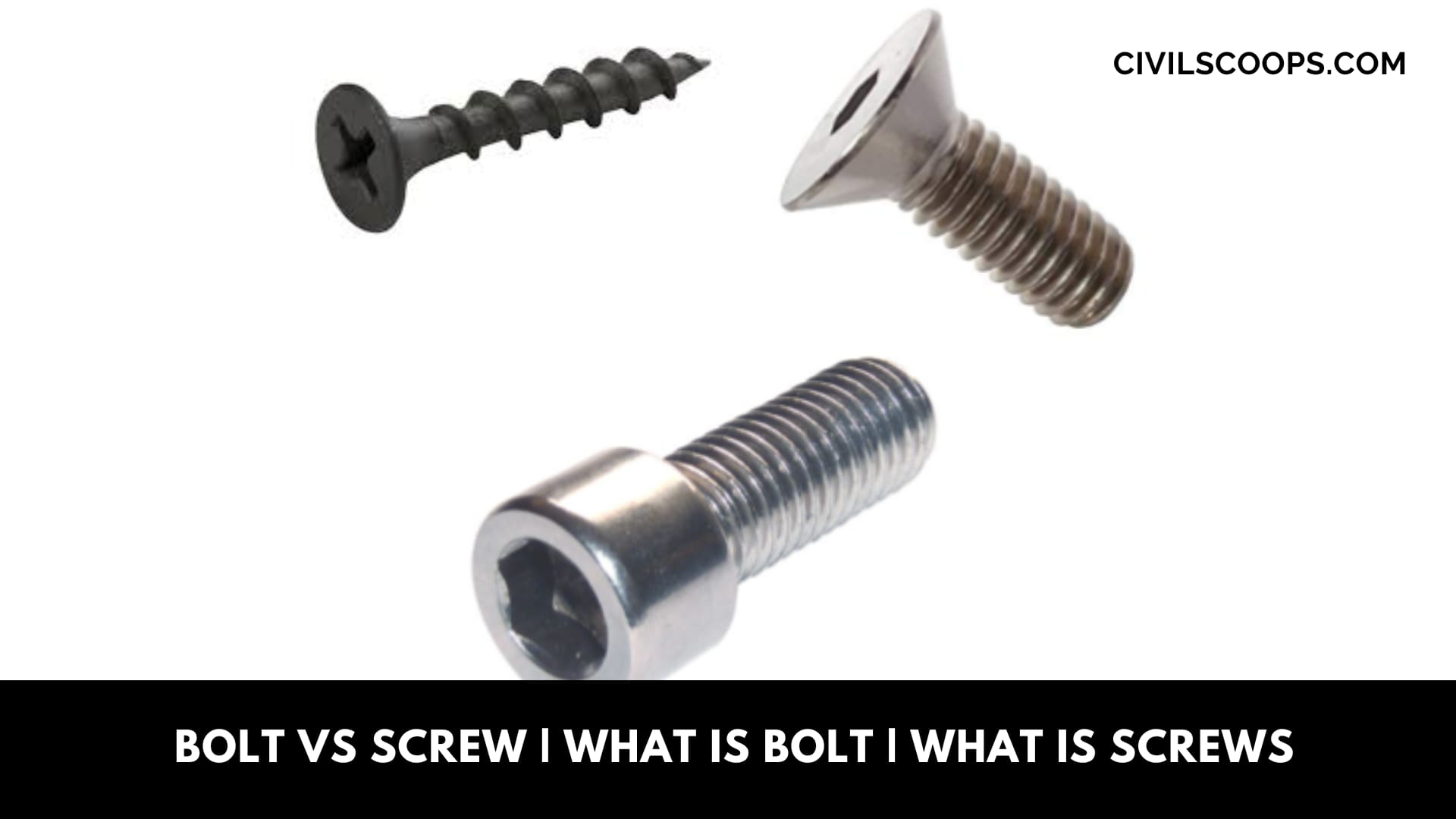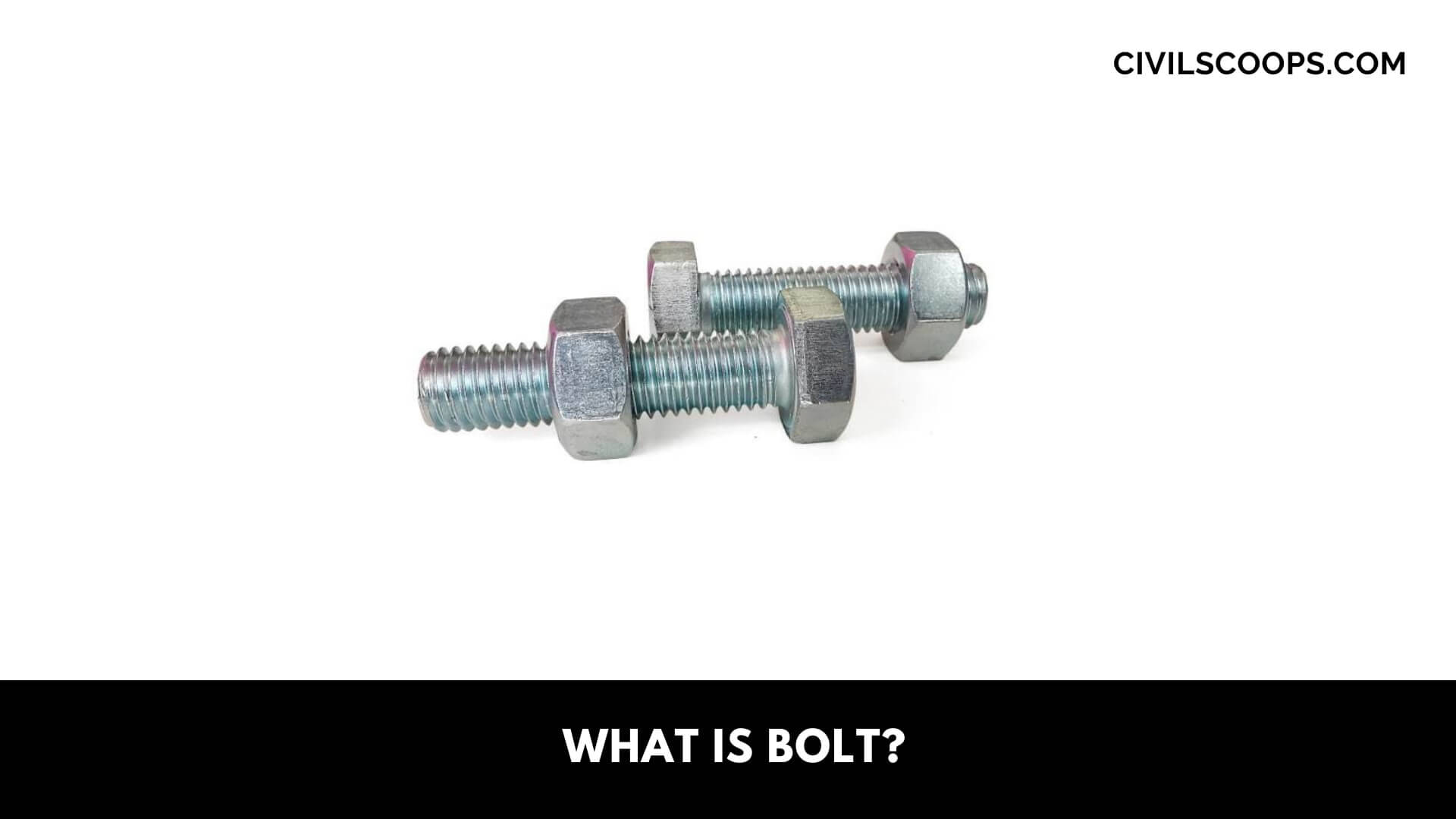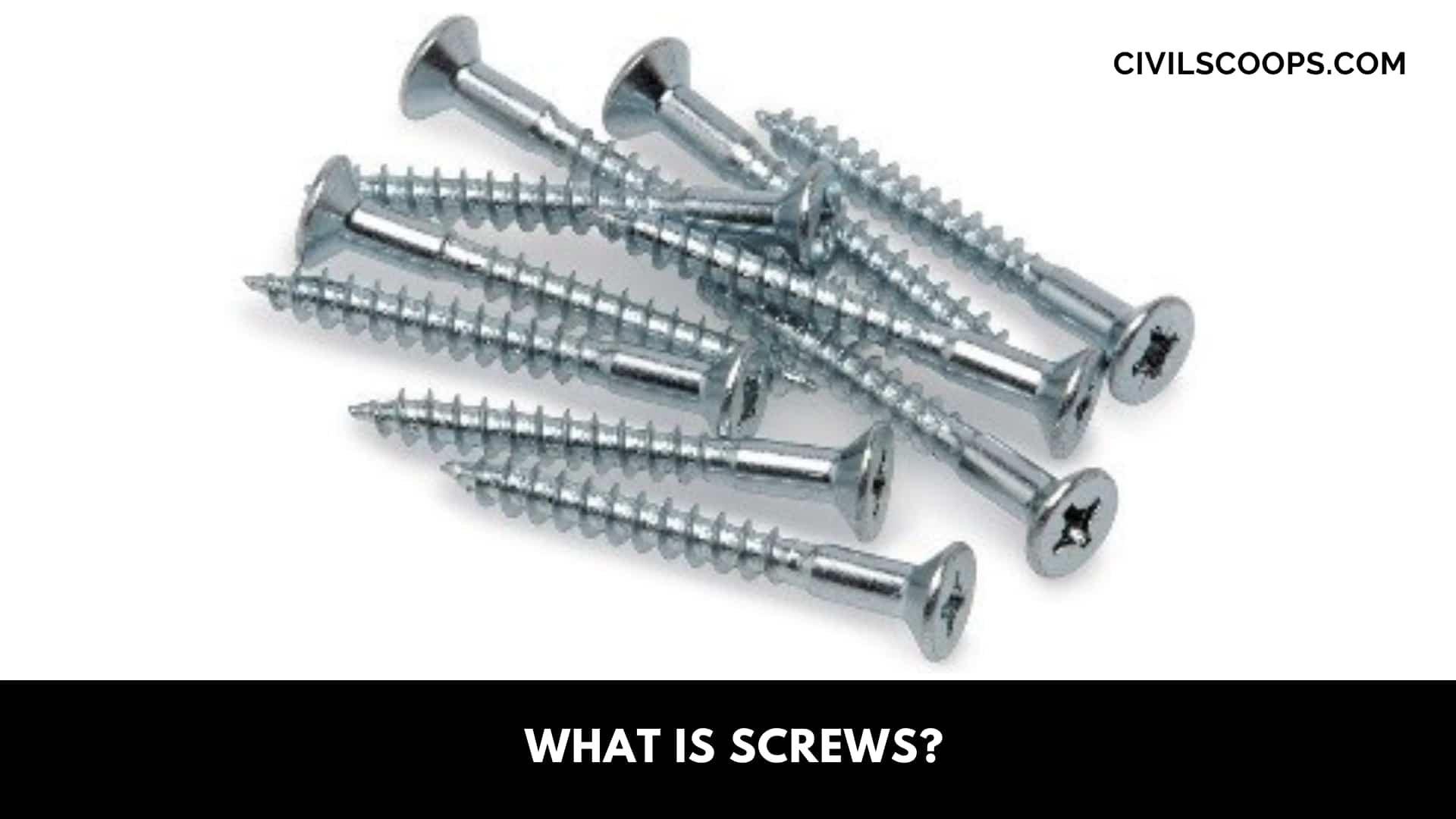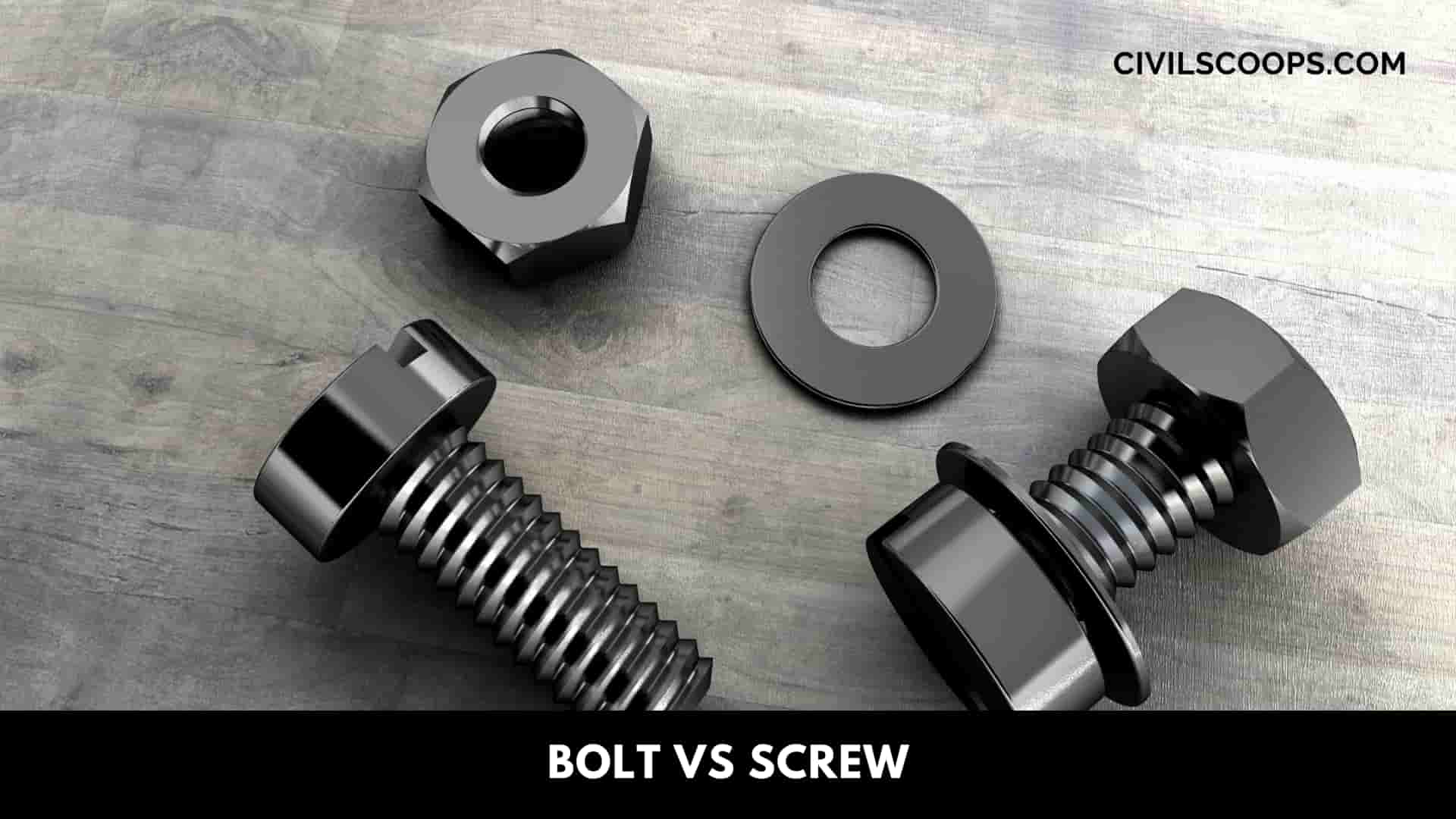Bolt Vs Screw | What Is Bolt | What Is Screws

Table of Contents
What Is Bolt?

A bolt is an externally threaded fastener created for the insertion through holes in the assembled parts. Generally, bolts are intended to be released by nuts.
This Bolts in a uniform circular cross-section, the threads are spiral in structure and have a smaller pitch as compared to screws. These bolts don’t have tapered shanks, and the parts secured by bolts possess greater strength than parts secured by screws.
These bolts act on the application together with the nut and are tightened on the part in which the torque is applied. Some of the generally used bolts are plow bolts, carriage bolts, and track bolts. The reliability and durability of parts joined by bolts are much higher than those joined by screws.
Applications that use bolts include flange joints or fastening of objects made of metal materials. Moreover, bolts aren’t only used in machinery but also plumbing and electronics. Z Bolts are an integral part of equipment and component reliability.
Also Read: What Is Formwork | Types of Formwork| Formwork in Construction| Formwork Materials
Bolt Pretension

Bolt Preload – The tension created when the nut is screwed onto a bolt to hold two materials together.
When the tension reaches the optimal preload, the working load (load added after creating the assembly) placed on a bolt will be distributed into the installation materials, so the bolt does not take the entire load.
What Is Screws?

A screw may be defined as an inclined plane wrapped around a nail and characterized by a helical ridge. In other words, it is a long metal shaft with threads circling along its length. It also has a turning where a screwdriver can be used to rotate the screw.
A screw generally has a head with a specially formed shape. The shape determines and heads size the size of the tool to be used to turn or drive the screw. Commonly used tools are wrenches and screwdrivers.
The underside part of the head is a shank that can be fully or partially threaded. A screw thread is a structure on a coned or cylindrical shape in the form of a helix.
The top of the ridge is known as a crest and the bottom root. The distance between the crest of the one thread to the next one is known as a pitch.
Screws are tightened by rotating the tool anticlockwise or clockwise and are usually used for joining materials that don’t have existing holes in them.
The most common types of screws used in manufacturing are drywall screws, dowel screws, mirror screws, and concrete screws. The strength of a screw relies on the width of the thread and the distance between them.
However, the more numbers of the threads, the more rotations would be required to attach the screw. Also, if the continuous distance thread is wider, more force must be exerted on the tool in the rotations.
Screws are widely used in many applications. From motorcycles to furniture, from air conditioners to kid’s remote control cars.
Also Read: Difference Between Veneer and Laminate | What Is Veneer | What Is Laminate
Bolt Vs Screw

Difference between nolt and screw are as follows.
[su_table responsive=”yes” alternate=”no”]
| Sr.No. | Bolt | Screw |
| 1 | Screws are tightened by rotating the tool clockwise and are usually used for joining materials that do not have existing holes in them. |
A screw is an externally threaded fastener capable of being inserted into holes in assembled parts, of mating with a preformed internal thread or forming its own thread, and of being tightened or released by torquing the head.
|
| 2 | Bolt is always used in pair like nut & Bolt |
Screws are always used by itself.
|
| 3 | Bolts are used with un-threaded components. |
Screw can be used with threaded or un-threaded components.
|
| 4 | In the bolt cross Uniform section |
In screw can have non- uniform cross section
|
| 5 | The threads are spiral in shape. |
The threads are helical in shape.
|
| 6 | It doesn’t have tapered shank. |
It has tapered or pointed shank.
|
| 7 | This Bolts mostly require wrenches and spanners for the tightening and loosening purposes. |
This screw requires mostly screw drivers for the tightening and loosening purposes.
|
| 8 | This bolt is reliable |
Here, Screw is less reliable
|
| 9 | Bolts are larger in size. |
Screws are smaller than bolts.
|
| 10 | Larger size bolts are used to achieve higher load-carrying capacity. |
Screws are not available in very large size. They are generally used for low load carrying applications.
|
| 11 | Bolt are always fixed at a single position with the use of a tool. |
Screws has to be turned every time it has to be assembled.
|
| 12 | They apply compression on the parts that they join. |
They don’t apply compression on the parts that they join.
|
| 13 | They are often used in the making of bolted joints. |
They can’t be involved in the bolted joint making due to the presence of at least one thread.
|
| 14 | The examples of bolts are Anchor bolt, T-head bolt, Toggle bolt, U-bolt, J-bolt, Eyebolts, Hexagon bolt/Tap bolt, Lag bolt, Machine bolt, Carriage bolt, Elevator bolt, Flange bolt, Hanger bolt, Plow bolt, Sex bolt, Shoulder bolt, Square head bolt, Stud bolt, Timber bolt, etc. |
The examples of screws are self-drilling, socket screw, eye lag, mating screw, Wood screw, machine screw, thread cutting machine screw, sheet metal screw, set screw, etc
|
[/su_table]
[su_box title=”FAQ” style=”default” box_color=”#333333″ title_color=”#FFFFFF” radius=”3″ class=”” id=””]
What Is a Lag Bolt?
Lag bolts, also called lag screws, are large wood screws with hexagonal heads that are perfect for projects like mounting your new flat screen TV in your house.
What Is a Lag Screw?
Also commonly known as lag bolts, lag screws are some of the toughest fasteners. These extremely sturdy fasteners are usually used to connect heavy lumber or other heavy materials that are bearing an intense load.
What Is Nut and Bolt?
Bolts are threaded fasteners with external male threads. They mate with nuts, which have female – meaning, internal – threads.
What Are Bolts Made of?
Typically, screws and bolts are made from steel due to its strength and relatively inexpensive cost. However, screws and fasteners can also be produced from stainless steel, brass, titanium, and a wide range of other metals depending on the intended application.
What Are Carriage Bolts Used for?
Carriage bolts are used to hold together wood with wood, wood with metal and even metal with metal. Their particular shape allows the bolt to be self-locking when placed through a square hole, especially when dealing with metal.
What Are Nuts and Bolts Made of?
Bolts and nuts are fabricated from a variety of materials. These options include metals and polymers. Stainless steel offers strength and corrosion resistance, while the polymer options have less strength than stainless, they are a good choice for resisting chemicals.
What Is Screws?
A short, slender, sharp-pointed metal pin with a raised helical thread running around it and a slotted head, used to join things together by being rotated so that it pierces wood or other material and is held tightly in place.
What Is a Pan Head Screw?
Pan head screws are threaded fasteners with a similar non-countersunk, mushroom-shaped head. They are commonly used to fasten wooden workpieces. Pan head is one of the most common types of screws. They are known as “pan head screws” because their head resembles a pan.
What Is a Machine Screw?
A machine screw is a type of threaded fastener that’s designed for use in a machine. It’s driven into a pre-cut hole where it holds a machine’s parts together. Machine screws consist of a head, followed by a fully threaded shank.
What Are Screws Used for?
The most common uses of screws are to hold objects together — such as wood — and to position objects. Often screws have a head on one end of the screw that allows it to be turned.
Bolt Pretension
Bolt Preload is a term that refers to the tension created when a nut works with a bolt to hold together two materials. As the tension hits the optimal preload, the working load acting on a bolt is distributed across the assembly, in order to prevent the bolt from bearing the complete load.
Minimum Bolt Pretension
Minimum pretension values are set at 70% of the minimum tensile strength of the fastener using a specific calculation of the stress area through the bolt threads. This accounts for both the thread type and pitch.
Difference Between Bolt and Screw
They are both threaded fixings and have a head for tightening the fastener but there is more to it than that. The most obvious way of differentiating between a bolt and a screw is that a bolt is not usually threaded all the way along its shank as it has a plain portion. A screw, however, is threaded fully to the head.
[/su_box]
[su_note note_color=”#F2F2F2 ” text_color=”#333333″ radius=”3″ class=”” id=””]
Like this post? Share it with your friends!
Suggested Read –
- Types of Kitchen Faucets
- What Is Bridge Pier | Type of Bridge Pier
- Difference Between Beam and Column | What Is Beam | What Is Column
- What Is Bow Window | Types of Bow Windows | Bow Window Sizes | Advantages & Disadvantages of Bow Window
- What Is Drywall | Drywall Water Damage | Drywall Water Damage Repair | Cost to Repair Drywall Ceiling Water Damage
[/su_note]
Originally posted 2023-04-12 06:40:18.
